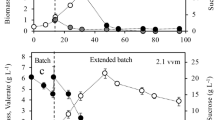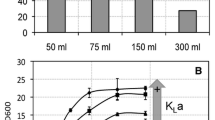Abstract
To produce polyhydroxyalkanoate (PHA) copolymer which consists of 3-hydroxy-butyrate (3HB) and 3-hydroxyhexanoate (3HHx) by cultivation ofAeromonas hydrophila, fed-batch cultures were done under several nutrient limiting conditions. With the results from flask cultures, fed-batch cultures were carried out to produce large amounts of PHA. In the fed-batch culture, firstly glucose was fed to grow cell, and then, oleic acid fed to stimulate PHA in the cell. The final cell concentration, PHA content, PHA concentration, and 3-hydroxy-hexanoate fraction in 38 hr were 48.9 g/L, 15.05 wt%, 7.36 g/L and 12.2 wt%, respectively, resulting in the productivity of 0.19 g/L-h under phosphate-limiting condition.
Similar content being viewed by others
References
Anderson, A. J. and E. A. Dawes (1990). Occurrence, metabolism, metabolic role, and industrial uses of bacterial polyhydroxyalkanoates.Microbiol. Rev. 54, 450–472.
Lee, S. Y. (1996) Bacterial polyhydroxyalkanoates.Biotechnol. Bioeng. 49, 1–14.
Steinbuchel, A. and B. Fuchtenbusch (1998) Bacterial and other biological systems for polyester production.Trends in Biotechnol. 16: 419–427.
Doi, Y. (1990)Microbial polyesters. VCH, New York, NY, U.S.A.
Lee, S. Y. (1996) High cell density cultivation ofPseudomonas oleovorans for the production of poly(3-hydroxyalkanoates).Biotechnol. Bioproc. Eng. 1: 51–53.
Lee, S. Y. and H. N. Chang (1995) Production of poly-(hydroxyalkanoic acid).Adv. Biochem. Eng. Biotechnol. 52: 27–58.
Lee, S. Y. and J. Choi (1999) Polyhydroxyalkanoates: biodegradable polymer, pp. 616–627. In: A. L. Demain, and J. E. Davies (ed.)Manual of industrial microorganisms and biotechnology 2nd ed. American society for Microbiology, Washington, D. C.
Doi, Y., S. Kitamura, and H. Abe (1995) Microbial synthesis and characterization of poly(3-hydroxybutyrate-co-3-hydroxyhexanoate).Macromolecules 28: 4822–4828.
Brandl, H., E. J. Knee, R. C. Fuller, R. A. Gross, and R. W. Renz (1989) Ability of the phototrophic bacteriumRhodospirillum rubum to produce various poly(3-hydroxyalkanoates): potential sources for biodegradable polyester.Int. J. Biol. Macromol. 11: 49–55.
Liebergesell, M., E. Hustede, A. Timm, A. Steinbuchel, R. C. Fuller, R. W. Lenz, and H. G. Schlegel (1991) Formation of poly(3-hydroxy-alkanoates) by phototrophic and chemolithotrophic bacteria.Arch. Microbiol. 155: 415–421.
Haywood, G. W., A. J. Anderson, G. A. Williams, E. A. Dawes, and D. F. Ewing (1991) Accumulation of a poly(hydroxyalkanoate) copolymer containing pri-marily 3-hydroxyvalerate from simple carbohydrate substrates byRhodococcus sp. NCIMB 40126.Int. J. Biol. Macromol. 13: 83–87.
Kato, M., H. J. Bao, C. K. Kang, T. Fukui, and Y. Doi (1996) Production of a novel copolyestement 3-hydroxybutyric acids and medium-chain-length 3-hydroxyalkanoic acids byPseudomonas sp 61-3 from sugars.Appl. Microbiol. Biotechnol. 45: 363–370.
Steinbuchel, A. and S. Wiese (1992) APseudomonas strain accumulating polyesters of 3-hydroxybu-tyric acid and medium-chain-ength 3-hydroxy alkanoic acids.Appl. Microbiol. Biotechnol. 37: 601–697.
Fukui, T. and Y. Doi (1997) Cloning and analysis of the poly(3-hydroxybutyrate-co-3-hydroxyhexanoate) biosynthesis genes ofAeromonas caviae.J. Bacteriol. 179: 4821–4830.
Fukui, T., N. Shiomi, and Y. Doi (1998) Expression and characterization of (R)-specific enoyl coenzyme A hydratase involved in polyhydroxyalkanoate biosynthesis byAeromonas caviae.J. Bacteriol. 180: 667–673.
Kobayashi, G., T. Shiotani, Y. Shima, and Y. Doi (1994) Biosynthesis and characterization of poly (3-hydroxybutyrate-co-3-hydroxyhexanoate) from oils and fats byAeromonas sp. OL-338 andAeromonas sp. FA-440. p. 410–416.In Y. Doi and K. Fukuda (ed.), Biodegradable Plastics and Polymers Elsevier Science, Netherland.
Wang, F. and S. Y. Lee (1998) High cell density culture of metabolically engineeredEscherichia coli for the production of poly(3-hydroxybutyrate) in a defined medium.Biotechnol. Bioeng. 58: 325–328.
Kim, G. J., I. Y. Lee, S. C. Yoon, Y. C. Shin, and Y. H. Park (1997) Enhanced yield and a high production of medium-chain-length poly(3-hydroxy-alkanoates) in a two-step fed-batch cultivation ofPseudomonas putida by combined use of glucose and octanoate.Enzyme Microb. Technol. 20: 500–505.
Braunegg, G., B. Sonnleitner, and R. M. Lafferty (1978) A rapid gas chromatographic method for the determination of poly-3-hydroxybutyric acid in microbial biomass.Eur. J. Appl. Microbiol. Biotechnol. 6: 29–37.
Author information
Authors and Affiliations
Corresponding author
Rights and permissions
About this article
Cite this article
Lee, Y., Lee, S.H. & Lee, S.Y. Fed-batch culture ofAeromonas hydrophila for the production of poly(3-hydroxubutyrate-co-3-hydroxyhexanoate) using two carbon sources. Biotechnol. Bioprocess Eng. 4, 195–198 (1999). https://doi.org/10.1007/BF02931928
Issue Date:
DOI: https://doi.org/10.1007/BF02931928




